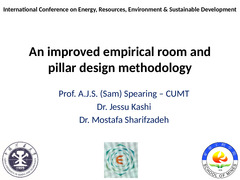An improved empirical room and pillar desin methodology
编号:505
访问权限:仅限参会人
更新:2022-05-24 02:46:51
浏览:1337次
特邀报告

报告开始:2022年05月27日 08:40 (Asia/Shanghai)
报告时间:20min
所在会议:[S1] Resource Development and Utilization » [S1-2] Resource Development and Utilization-2
摘要
Empirical pillar design methods are commonly used in the mining industry. The parameters within which these pillar design methods are valid are frequently unknown to the user or ignored. In addition, the empirical design may not consider essential parameters such as blasting effects, orebody dip and the presence of geological structures, which all adversely affect the stability of the pillars. This can result in potentially serious pillar design strength over-estimates. Although the commonly based Tributary Area Method is generally conservative, as the spans are seldom that large relative to the depth, failing to consider other relevant parameters can result in errors. Problems associated with an under-designed pillar can range from a local pillar collapse to a catastrophic chain reaction pillar collapse (or run). Over designed pillars are generally safe but reduce the extraction of the orebody, so they adversely affect the profitability of the mining operation. Therefore, laboratory tests and numerical modelling were used to understand the effects of orientation of pillars, blasting and presence of discontinuities on pillar strength. Reduction factors were developed with these models to be implemented in conjunction with the existing pillar empirical design methods. For any pillar or mine design, once it is implemented, the actual performance of the system must be checked regularly by observation and monitoring and adjusted if needed. The pillar design approach outlined in this paper can better optimize the pillar mining method by considering other generally ignored but important parameters, thus improving safety, productivity and economic aspects.
关键字
Pillar, Tributary Area Theory, Geological structures, Orebody dip, width to height (W/H) ratio.
发表评论